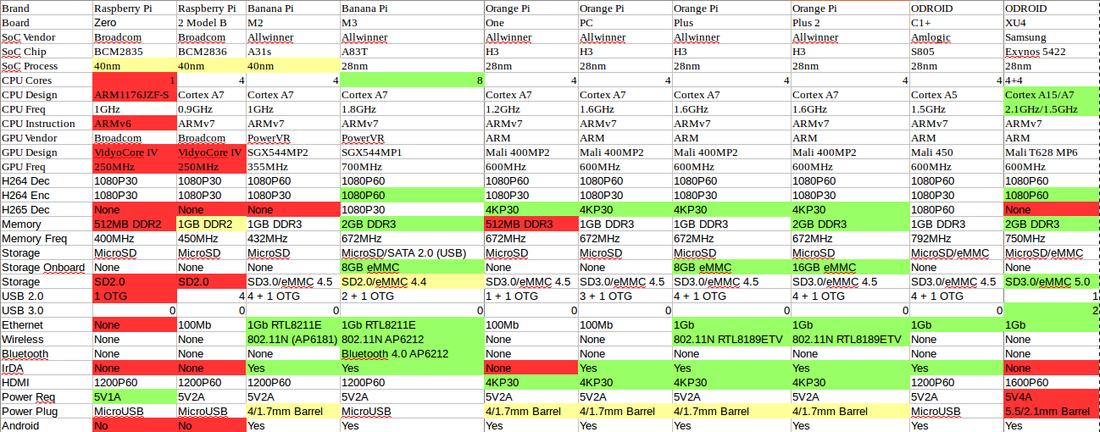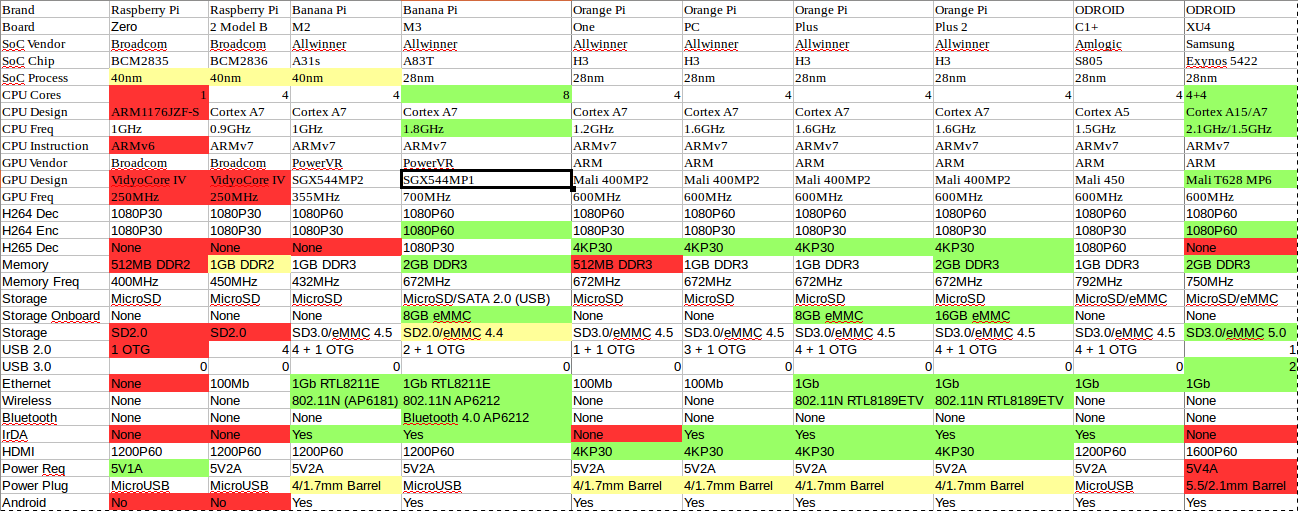
Raspberry Pi, Banana Pi, Orange Pi, ODROID Differences and Chart
Share
We sell a lot of boards and one of the often asked questions is the difference between all the boards. We will try to highlight the differences and which board is best for your use-case.
 Green - Great!, Yellow - Attention, Red - Not so great :(
Green - Great!, Yellow - Attention, Red - Not so great :(
Image Copyright LoveRPi
Raspberry Pi 2 Model B
This board has the best marketing, the largest community, and the most sales. You will find people using this board to do everything under the sun which means it has the most accessories. It is also very expensive for the performance and features you get. It is based on an ARMv7 Quad Core Broadcom SoC. Broadcom has not been an opensource friendly company and they use patented technologies like FAT32, VideoCore, and others so implementing commercial designs is somewhat of a challenge. Mainline support should be in Linux Kernel 4.5.
It does not support Google Android, UHS MicroSD cards, or Gigabit Ethernet.
It has 1GB DDR2 RAM, MIPI DSI Display support, and CSI Camera support.
Raspberry Pi Zero
This board is basically vaporware at this point. It is using the old ARMv6 instruction set which is outdated and slow. It has the smallest form factor of any popular SBC.
Banana Pi M2
Based on the Allwinner A31s ARMv7 Quad Core SoC, this SBC was first supported by the Mainline Kernel 4.0. Since the SoC was built for tablets, it supports Android.
It also requires a 4.0mm/1.7mm barrel power plug like the Orange Pi's to power the board properly.
It has 1GB DDR3 RAM, onboard WiFi, LVDS Display support, IR Receiver, Gigabit Ethernet, and power buttons.
Banana Pi M3
Based on the Allwinner A83T ARMv7 Octo (8) Core SoC, this SBC will be supported by the Mainline Kernel 4.6. This high performance SoC can scale up to 2GHz per core. In combination with a heatsink and active cooling, it can triple the performance of the Raspberry Pi 2.
It has 2GB DDR3 RAM, onboard WiFi, 1080P60 H264 Encoding/1080P60 H265 Decoding, SATA via USB bridge, and Bluetooth.
Orange Pi One
Based on the Allwinner H3 ARMv7 Quad Core SoC, this SBC is supported by the Mainline Kernel 4.2. This cost effective SoC supports 4K Video Decoding. This board has 512MB.
Orange Pi PC
Based on the Allwinner H3 ARMv7 Quad Core SoC, this SBC is supported by the Mainline Kernel 4.2. This cost effective SoC supports 4K Video Decoding. This board has 1GB DDR3.
Orange Pi Plus
Based on the Allwinner H3 ARMv7 Quad Core SoC, this SBC is supported by the Mainline Kernel 4.2. This cost effective SoC supports 4K Video Decoding. This board has 1GB DDR3.
Orange Pi Plus 2
Based on the Allwinner H3 ARMv7 Quad Core SoC, this SBC is supported by the Mainline Kernel 4.2. This cost effective SoC supports 4K Video Decoding. This board has 2GB DDR3.
ODROID C1+
Based on the AMLogic S805 SoC, this SBC shares a similar form factor as the Raspberry Pi 2. Mainline Kernel support is unknown.
ODROID XU4
Based on the Samsung Exynos 5542 SoC, this is the fastest SBC of the bunch.